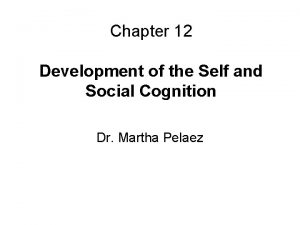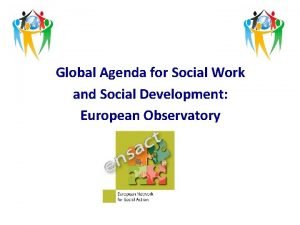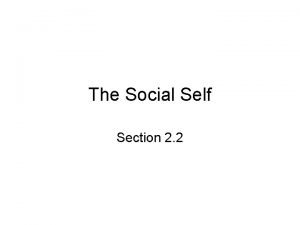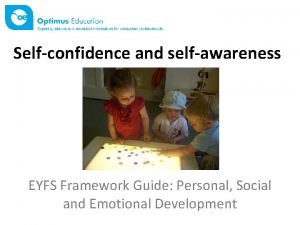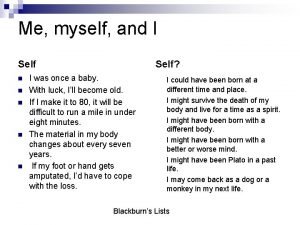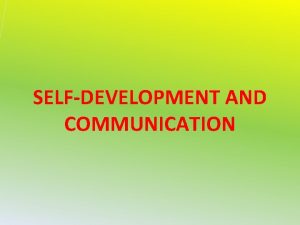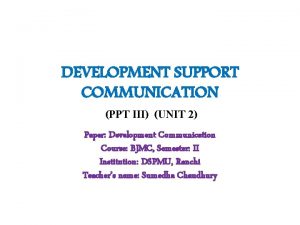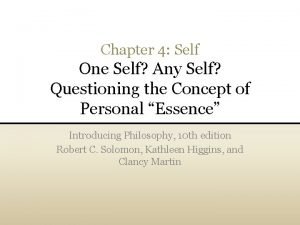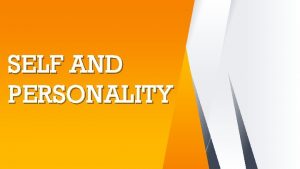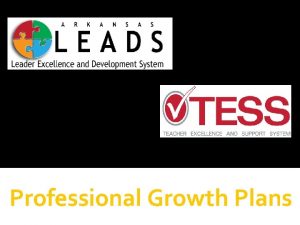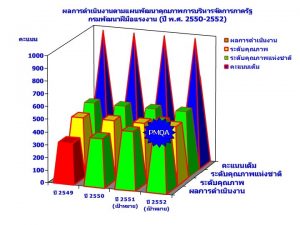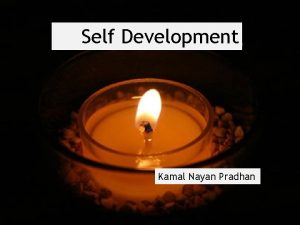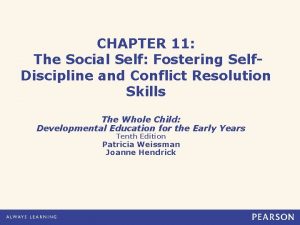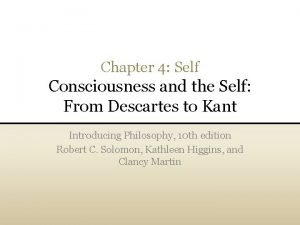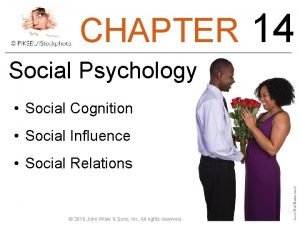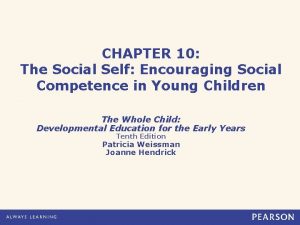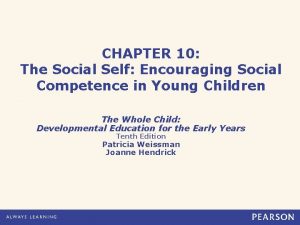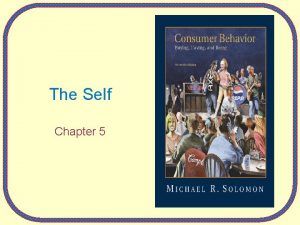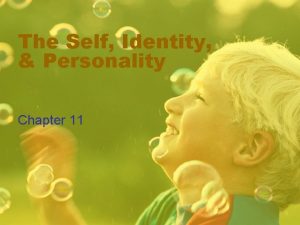Chapter 12 Development of the Self and Social



























- Slides: 27

Chapter 12 Development of the Self and Social Cognition Dr. Martha Pelaez

Development Of The Self-Concept • Most developmentalists believe that infants are born without a self-concept and gradually come to distinguish themselves form the external environment over the first 2 to 6 months, as they gain a sense of personal agency and learn to discriminate their faces from those of other people

Development Of The Self. Concept Cont… • Who are you really? Are you the person that you are because of your unique personality, physical and mental abilities etc. Or do you get information about who you are from outside influences? • The concept of self implies that people are a combination of physical and psychological attributes that are unique to that individual.

Development Of The Self-Concept Cont… • The looking-glass self is the idea that a child’s self concept is largely determined by the ways other people respond to him or her. • Social cognition - thinking people display about the thoughts, feelings, motives and behaviors of themselves and other people. • Self concept - one’s perceptions of one’s unique attributes or traits.

The Emerging Self: Differentiation and Self Recognition Spatial awareness is something that can be noted at very early stages in human development. It is suggested that this ability to sense one’s location is a result of: Proprioceptive feedback - sensory information from the muscles, tendons, and joints that help one to locate the position of one’s body (or body parts) in space. *Infants rely very heavily on this feedback.

The Emerging Self: Differentiation and Self Recognition cont… • As infants interact and gain more experience in their environments they begin to become aware of: • Personal agency - recognition that one can be the cause of an effect. • Infants as young as 2 months newborns have this recognition.

Self Recognition • Self recognition - the ability to recognize oneself in a mirror or photograph. • Present self - early self-representation where 2 and 3 -year-olds recognize current representations of self but are unaware that the past self - representations or self-relevant events have implications for the present. • Extended self - more mature self-representation, emerging between ages 3 1/2 and 5 years, in which children are able to integrate past, current and unknown future self.

Self Recognition cont… *One social and emotional consequence of self recognition is: • The categorical self - a person’s classification of the self along socially significant dimensions such as age and sex. – This usually occurs once toddlers display selfrecognition

Who am I? • Who am I? Responses of Preschool Children- Until recently, developmentalists believed that the self-concepts of preschool children were concrete, physicalistic, and nearly devoid of any psychological self awareness.

Children’s Theory of Mind and Emergence of the Private Self • When adults think about the self, they know that it consists of a public self (or me) that others can see an a private self (or I) that has an inner reflective (thinking) character not available to others. • Theory of mind - an understanding that people are cognitive beings with the mental states (beliefs, motives, feelings, and intentions) that are not always accessible to others and that often guide their behavior.

Early Understanding of Mental States: • Desire Theory: an early theory of the mind where a person’s actions are thought to be a reflection of her desires rather than other mental states such as beliefs. • Belief-desire theory of the mind: develops between age 3 and 4; child now realizes that both beliefs and desires may determine behavior and that people will act on their beliefs even if they are inaccurate. • False Belief problem: method of assessing one’s understanding that people can hold inaccurate beliefs that can influence their conduct even if the beliefs are wrong.

Conceptions of Self in Middle Childhood and Adolescence • Once children develop a theory of mind and clearly differentiate their public and private selves, their self-descriptions gradually evolve. • As children grow and acquire all of the components of self awareness they begin to make decisions as to whether or not they accept their true selves. Often times when if an adolescent/teen is not self confident they will engage in: – False self-behavior- acting in ways that do not reflect one’s true self.

Self-Esteem: The Evaluative Component Of Self • As children develop, they not only understand more about themselves and construct more intricate self-portraits, but they also begin to evaluate the qualities that they perceive themselves as having. This evaluative aspect of self is called self-esteem.

Self Esteem cont. . . – Origins and Development of Self-Esteem. Children's evaluation of themselves and their competencies is a most important aspect of self that can influence all aspects of their conduct and their psychological well-being. The theory predicts that securely attached children, who presumably construct a positive working model of self and others, should soon begin to evaluate themselves more favorably than insecurely attached children, whose working models are not so positive.

Self-Esteem cont. . . • Components of Self-Esteem- By early adolescence one's perceptions of self-worth become increasingly centered on interpersonal relationships. Susan Harter and her associates coined the term relational self-worth to describe their finding that adolescents often begin to perceive their self-worth somewhat differently in different relational contexts. • Changes in Self-Esteem- Young adolescents who experience the many physical, cognitive, and social changes associated with puberty often become confused and show at least some decline in self-esteem as they leave childhood behind and begin to search for a stable adult identity.

Self-Esteem cont. . . – Social Contributors to Self-Esteem • Parenting Styles- Parents can play a crucial role in shaping a child's self-esteem. The sensitivity of parenting early in childhood clearly influences whether infants and toddlers construct positive or negative working models of self • Peer Influences- As early as age 4 or 5 children are beginning to recognize differences among themselves and their classmates as they use social comparison information to tell them whether they perform better or worse in various domains than their peers.

Development of Achievement Motivation and Academic Self. Concepts • Achievement motivation - a willingness to strive to succeed at challenging tasks and to meet high standards of accomplishment. – Phase 1: Joy of Mastery – Phase 2: Approval Seeking – Phase 3: Use of Standards

Achievement Motivation during Middle Childhood and Adolescence – Home Influences on Mastery Motivation and Achievement- Researchers have identified three especially potent home influences on children's mastery and achievement motivation and actual achievement behavior, they are: • Quality of Attachment • The Home Environment • Child Rearing and Achievement

Achievement Motivation cont. . . • Peer Group Influences- Peers are also an important source of influence on gradeschool children and adolescents who may sometimes support and at other times undermine parents' efforts to encourage academic achievement.

Beyond Achievement of Motivation • Development of Achievement Attributions – Types of Achievement Attributions • • Ability Effort Task Difficulty Luck

Beyond Achievement cont. . . – Age differences in achievement-related attributions- Young children do seem to have an incremental view of ability: They believe that ability is changeable, not stable, and that they can get smarter or become more capable through increased effort and lots of practice. – Dweck's Learned-Helplessness Theory • How does learned helplessness develop? • On helping the helpless to achieve.

Methods used to Help the Helpless to Achieve • • • Attribution retraining Person praise Performance goal Process-oriented praise Learning goals

Who Am I To Be? Forging An Identity • Identity - a mature self-definition; a sense of who one is, where one is going in life and how one fits into society. • Identity crisis - Erickson’s term for the uncertainty and discomfort that adolescents experience when they become confused about their present and future roles in life.

Who Am I To Be? cont… • James Marcia has developed a structured interview that allow researchers to classify adolescents into one of four identity statuses – 1. Identity diffusion – 2. Foreclosure – 3. Moratorium – 4. Identity achievement

Age Trends In Person Perception • Behavioral comparisons phase - the tendency to form impressions of others by comparing and contrasting their overt behaviors. *Increases between ages 6 and 8 and declines rapidly after age 9. • Psychological constructs phase - tendency to base one’s impressions of others on the stable traits these individuals are presumed to have. • Psychological comparisons phase - tendency to form impressions of others by comparing and contrasting these individuals on abstract psychological dimension

Theories of Social-Cognitive Development • Cognitive-Developmental Theory • Selman’s Role-Taking Theory • Role Taking and Thinking about Relationships

Social Influences on Social. Cognitive Development – Social Experience as a Contributor to Role. Taking- It seems that equal-status contacts among friends may be especially important for the growth of role-taking skills and interpersonal understanding. – Social Experience as a Direct Contributor to Person Perception- It seems that both social experience and cognitive competence contribute in their own ways to the development of children’s understanding of other people.
 Ideal vs actual self
Ideal vs actual self Development of self and social understanding
Development of self and social understanding Global agenda for social work and social development
Global agenda for social work and social development Social thinking and social influence in psychology
Social thinking and social influence in psychology Social thinking social influence social relations
Social thinking social influence social relations I self and me self difference
I self and me self difference Self confidence and self awareness eyfs
Self confidence and self awareness eyfs I-self and me-self
I-self and me-self Self development in business communication
Self development in business communication Role of communication in development ppt
Role of communication in development ppt Hình ảnh bộ gõ cơ thể búng tay
Hình ảnh bộ gõ cơ thể búng tay Ng-html
Ng-html Bổ thể
Bổ thể Tỉ lệ cơ thể trẻ em
Tỉ lệ cơ thể trẻ em Voi kéo gỗ như thế nào
Voi kéo gỗ như thế nào Chụp tư thế worms-breton
Chụp tư thế worms-breton Chúa yêu trần thế
Chúa yêu trần thế Kể tên các môn thể thao
Kể tên các môn thể thao Thế nào là hệ số cao nhất
Thế nào là hệ số cao nhất Các châu lục và đại dương trên thế giới
Các châu lục và đại dương trên thế giới Công thức tính thế năng
Công thức tính thế năng Trời xanh đây là của chúng ta thể thơ
Trời xanh đây là của chúng ta thể thơ Mật thư anh em như thể tay chân
Mật thư anh em như thể tay chân Làm thế nào để 102-1=99
Làm thế nào để 102-1=99 Phản ứng thế ankan
Phản ứng thế ankan Các châu lục và đại dương trên thế giới
Các châu lục và đại dương trên thế giới Thơ thất ngôn tứ tuyệt đường luật
Thơ thất ngôn tứ tuyệt đường luật Quá trình desamine hóa có thể tạo ra
Quá trình desamine hóa có thể tạo ra

